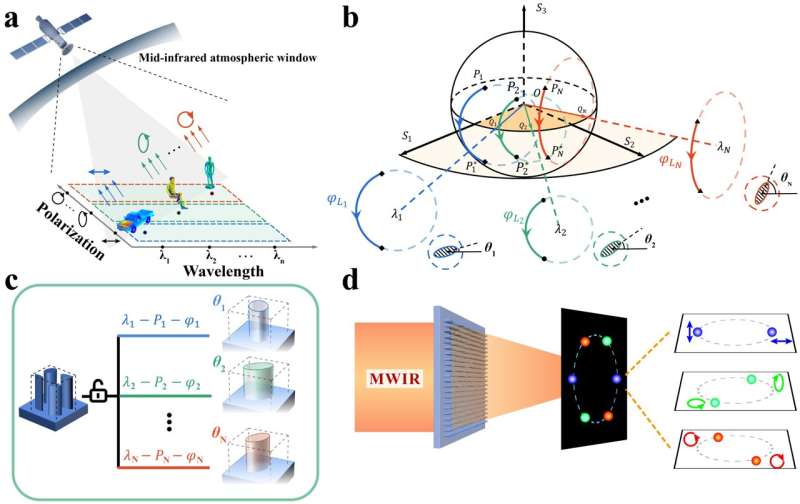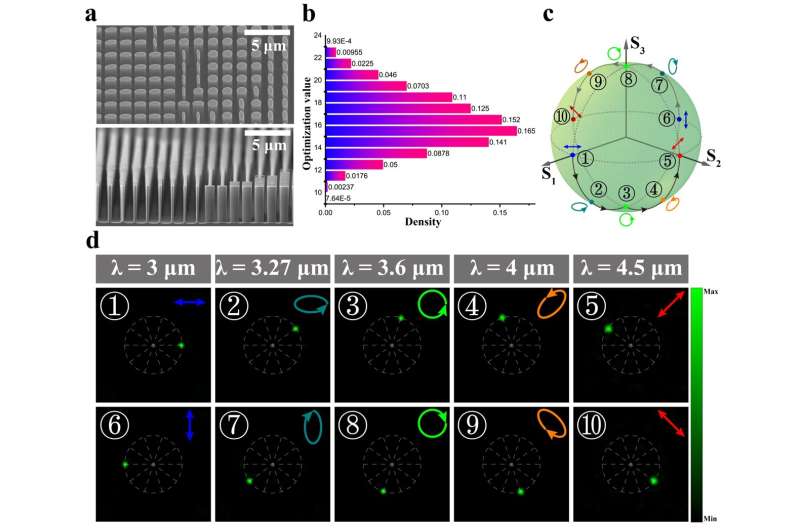This article has been reviewed according to Science X's editorial process and policies. Editors have highlighted the following attributes while ensuring the content's credibility:
fact-checked
peer-reviewed publication
trusted source
proofread
Polychromatic full-polarization control in mid-infrared light

Mid-wavelength infrared (MWIR) as one of the most important transparent atmosphere windows is less sensitive to interference from the background emission of the sun, providing a high-transmission zone for the finger-print spectra of various materials and enabling the communication channels between space and ground. Fundamental characteristics of photons, wavelength, polarization and their measurements are of great interest in almost all areas of science and in remote sensing technology. However, the crosstalk among various polarization and wavelength channels prevents accurate mid-infrared detections at high signal-to-noise ratio.
In a new paper published in Light: Science & Applications, a team of scientists, led by Dr. Guanhai Li from Shanghai institute of technical physics and Dr. Cheng-wei Qiu from National University of Singapore have proposed the dispersive Jones matrix method by constructing wavelength-decoupled coherent pixels based on an all-silicon metasurface. Without spatial or time costs and crosstalk, this method enables the independent phase manipulations on any desired orthogonal polarization channels at predefined discrete wavelengths.
A typical scenario for onboard payloads that are carried in satellites or airplanes to capture fine features of targets on the ground [car (λ1, P1), man (λ2, P2), and model (λ3, P3)] in a low-illumination background is shown in Figure 1. In order to obtain the information from different wavelengths and polarizations, traditional optical systems with cascaded elements have been explored to separately acquire spectrum or polarization information through rotating the discrete filters/polarizers or segmenting the detecting focal plane arrays. These configurations suffer from bulky and redundant volume, low collection efficiency of photons, etc. More importantly, they were realized at the expense of decreasing spatial or temporal resolutions.

Metasurfaces that enable versatile nanoscale light control in manipulating multiple photon dimensions, such as wavelength, polarization, and phase, have substantially shown great potential to replace the redundant and complex systems in an easily integrated and multifunctional way. However, the modulation path is limited by the geometric symmetry direction for conventional metaatoms.
In order to break the eigen polarization constraints inherent to different wavelength-polarization manipulations, the group proposed a dispersive Jones matrix approach by constructing wavelength-decoupled coherent pixels with four all-silicon metaatoms. To ensure high performance of the supercell at all three wavelengths and six polarization channels, the periodic geometrical parameters of the supercell are optimized by a particle swarm-genetic algorithm and, thus, achieving arbitrary polarization modulation in multiple wavelength dimensions.
The joint research team has prepared a representative polychromatic full-polarization control metadevice and demonstrated the generation of achromatically focusing spots over three pairs of arbitrarily chosen orthogonal polarizations on spatially separated channels at three wavelengths. It mimics the function of cascading filter, polarizer and wave plate placed in parallel in conventional setups.
Three different pairs of orthogonal polarization states at three wavelengths are linear polarization at 3.0 μm, elliptical polarization (ellipse angle 30°) at 3.6 μm and circular polarization at 4.5 μm. Though the method is based on the wavelength-decoupled coherent pixel, each with only four conventional linear EPS metaatoms, it still works at multiple wavelengths and the form of polarization states are arbitrary. As an example, a ten-channel metadevice is realized as illustrated in Figure 2. The selected five pairs of orthogonal polarization states are shown in the Poincaré sphere, which agrees well with the design.
The joint research team has demonstrated the eigen-polarization engineering through theoretical analysis, simulations and experimental measurements. It broadens the polarization applications from scientific research to industry in an ultra-compact and integrated manner, which would require various cascaded elements in parallel otherwise.
More information: Jin Chen et al, Polychromatic full-polarization control in mid-infrared light, Light: Science & Applications (2023). DOI: 10.1038/s41377-023-01140-3
Journal information: Light: Science & Applications
Provided by Chinese Academy of Sciences





















